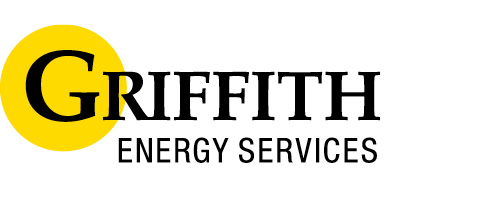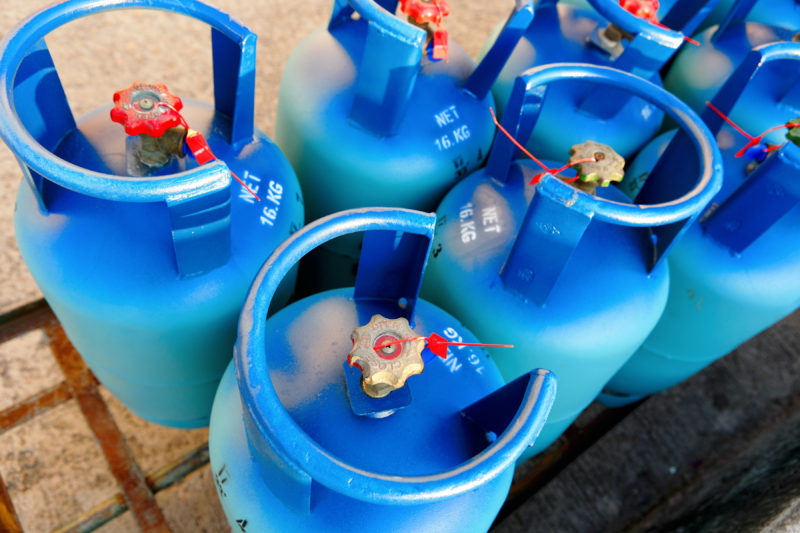Througout the Mid-Atlantic, many area homeowners depend on heating fuel to keep Old Man Winter at bay. For most furnaces and other domestic appliances, that means using either propane or natural gas. These common fuels may seem very similar, but they each have distinct properties that come with unique pros and cons. Understanding the differences between natural gas and propane is essential to choosing the right type of fuel for your home.
Composition and Environmental Impact
Natural gas is, to state the obvious, a naturally occurring gas. More specifically, it’s primarily methane (CH₄) mixed with small concentrations of a few other hydrocarbons. Natural gas is extracted from subsurface formations and refined into usable fuel, which is then supplied to homes and businesses via underground service lines. By contrast, propane (C₃H₈) is a byproduct produced by the processing and refinement of other petroleum products — including natural gas. Propane may also be called liquefied petroleum gas (LPG), though this umbrella term also encompasses other liquified gases.
Propane is the cleanest-burning fossil fuel available, producing only about half the carbon dioxide and other emissions of gasoline. It’s also not damaging to water or soil. Meanwhile, the methane in natural gas has a highly potent greenhouse effect, but this is partly offset by the fact that natural gas also burns cleanly and produces relatively little pollution. Most of the pollution related to natural gas comes from pipeline leaks, drilling accidents and other incidents. Over time, methane released from natural gas breaks down into carbon dioxide on its own.
Compared to electricity, both propane and natural gas are more environmentally friendly than you might expect. This is because about 20% of U.S. electrical power is still generated by coal-fired plants. Despite representing less than a quarter of power generation, these plants produce over half of all power-related emissions.
New Environmental Insights
Recently, there has been a growing emphasis on renewable energy sources, but natural gas and propane remain crucial transitional fuels. Innovations in carbon capture and storage (CCS) technology are being developed to mitigate the environmental impact of natural gas extraction and usage. Additionally, the production of renewable propane from bio-based feedstocks is gaining traction, further enhancing propane’s environmental profile.
Installation Process
Before you can crank up your furnace or fire up your favorite grill, you first need to secure your fuel supply. If you’re using natural gas, good news! Just ensure your appliances are hooked up correctly and your service line will provide all the gas you need. That is, of course, if you’re fortunate enough to live in an area that has access to local utilities and infrastructure.
If gas service isn’t available for your property, propane may be the perfect solution. Instead of being supplied by a municipal gas grid, propane is transported and stored locally in pressurized tanks. While small, lightweight cylinders are available for individual appliances, propane tanks for whole-home use are typically several feet long. They can be installed almost anywhere on your property and can be placed above or below the ground.
While aboveground tanks are more affordable and quicker to install, they may not fit so well with your landscaping. For a better-looking yard, consider decorating around your tank with fences, hedges, or a trellis with flowering vines. Having a tank buried is similar to having a natural gas pipeline connected to your home. A professional can replace any grass or other plants disturbed by either process. Before your installer begins, be sure to call the Federal “Call Before You Dig” number at 811 a few days in advance. This will give local utilities time to mark any underground lines or pipes in the area so your installer can avoid damaging them while digging.
Of course, even if your home is already set up for propane, that doesn’t mean you can’t change your fuel source. If you’d rather use natural gas or electricity, you can simply empty your propane tank and leave it in place. Alternatively, you can have it removed. While digging up an underground tank is no small task, you can offset the cost by selling it to someone else.
Want even better news? Many appliances are perfectly capable of burning both natural gas and propane. This makes it easier to switch between fuels, if necessary, but there’s a slight catch. The two fuels are supplied at very different pressures, which means they each require specialized fittings, regulators, and other components. To change from one fuel source to the other, you’ll likely need to buy conversion kits for each of your appliances. Unfortunately, gas conversion usually isn’t an option at all for electric appliances.
Updated Installation Considerations
With advancements in technology, smart home systems can now monitor propane levels and automatically schedule deliveries, ensuring you never run out of fuel. Additionally, remote monitoring systems for natural gas usage can help detect leaks and inefficiencies, providing peace of mind and enhancing safety.
Storage and Delivery Methods
For ease of storage, propane is always kept as a liquid inside a pressurized tank. This pressure is released when the propane flows through the valve on your tank, converting it back into its gaseous form. Conversely, natural gas can be stored as an uncompressed gas, as compressed natural gas (CNG), or as liquefied natural gas (LNG). Since LNG requires extremely cold temperatures, however, this form is only used for niche applications.
In terms of delivery, Griffith Energy Services offers affordable and convenient propane delivery throughout our entire service area. Our service technicians go where gas pipelines don’t, making propane a fantastic fuel choice for locals in remote or underserved communities.
On the downside, fuel deliveries take time and can occasionally be disrupted by large snowstorms and other unforeseen emergencies. Since natural gas comes to your home through pipes, it’s virtually always available when you need it. Unfortunately, this ample, steady supply of natural gas can turn unseen leaks into huge charges on your monthly utility bills. Because propane tanks only hold a finite supply, any leaks are likely to be a lot less costly.
Innovations in Storage and Delivery
Recent developments in propane storage technology have introduced composite cylinders that are lighter and more durable than traditional steel tanks. These cylinders are also more resistant to corrosion, making them safer and longer-lasting. For natural gas, advancements in pipeline monitoring and maintenance technologies are helping to reduce leaks and improve the reliability of delivery systems.
Efficiency and Cost
Propane is usually more expensive than natural gas on a per-unit basis, but it’s also much more efficient. In fact, propane produces about twice as much heat energy as an equivalent amount of natural gas. While propane is measured in gallons or liters, you’ll find natural gas measured in cubic feet or cubic meters. Professionals measure the heat from both types of fuel in British Thermal Units (BTUs). One BTU is the amount of energy needed to increase the temperature of one pound of water by one degree Fahrenheit.
Since prices vary from region to region, there’s no universal answer for which fuel is more economical. It’s easy to compare prices for your particular area but remember that propane delivers much higher efficiency. Ultimately, both types of fuel are more efficient and less expensive than electricity in many regions. Having a new natural gas line installed is more costly than getting a propane tank added to your home, but the investment could reduce your utility bills more if gas is available in your neighborhood.
Another important consideration is the appliances that are already in your home. Whether your furnace is electric, gas or propane, it often pays to replace old or outdated equipment. As a general rule of thumb, we recommend upgrading any furnace, air conditioner or other HVAC system that’s over 20 years old. This can help you avoid sudden, inconvenient breakdowns and reduce your utility bills by having a more efficient system installed. Propane heating systems are particularly long-lasting and less expensive to service and repair than heat pumps or electric furnaces.
Safety
Natural gas and propane are both virtually colorless and odorless. To make leaks easier to detect, manufacturers mix additives like mercaptans, tetrahydrothiophene and other chemicals into their products. While these additives are harmless, they produce a distinctive sulfur or “rotten egg” smell that can be detected even at very low concentrations.
If you notice this smell inside your home, extinguish any open flames and go outside immediately. After you’re away from your house, call 911. Don’t turn any electronics on or off and don’t plug in or unplug any devices. These actions could cause a spark, potentially resulting in an explosion. Leaks can also happen in underground pipes in your yard, so you should leave the area and call 911 if you smell sulfur or rotten eggs outdoors.
In the event of a propane leak, you can shut off your gas supply by locating the shutoff valve at the top of your tank and turning it clockwise. Since propane must be very cold to stay in a liquid form, most tanks are white to reflect as much heat and light as possible. If a container becomes too hot, a safety valve will open to relieve the pressure and prevent an explosion. Don’t let propane touch your skin since it can cause frostbite.
If you have a problem with your furnace, stove, water heater or any other system powered by propane or natural gas, be aware that incomplete combustion can form carbon monoxide. This colorless, odorless, tasteless gas is extremely dangerous and can even be deadly.
To protect yourself and your family, install carbon monoxide detectors in your home and always have malfunctioning equipment serviced by a professional as soon as possible. Signs of carbon monoxide exposure include headaches, dizziness, nausea, and other symptoms that improve when you leave the area. Open your doors and windows to let in fresh air and seek medical attention if you’ve been exposed.
Updated Safety Measures
Modern safety technologies include smart gas detectors that can alert you to leaks via your smartphone, providing an added layer of security. Additionally, advancements in carbon monoxide detector technology now offer features such as digital displays and voice alerts, making it easier to monitor your home’s air quality.
Natural Gas Vs. Propane: Which Fuel Is Best?
It may be anticlimactic, but this heavyweight bout is destined to end in a draw. There are plenty of differences between natural gas and propane, but both are affordable and effective fuel sources. While natural gas is extremely convenient and usually inexpensive, propane is generally considered somewhat safer, more efficient, and more eco-friendly. Ultimately, however, the best fuel for your home depends on your specific needs and circumstances. To help you find the best fit, here are a few key questions to mull over:
- Is your property already served by a storage tank or gas line?
- Do your current appliances run on propane or natural gas?
- How do fuel prices typically compare in your area?
- What is the cost of installing new infrastructure?
- Could upgrading your furnace or appliances save you money?
- Do you have a reliable source for local fuel delivery?
Common Questions and Answers
Q: Can I convert my propane appliances to natural gas or vice versa?
A: Yes, many appliances can be converted between natural gas and propane, but you’ll need a conversion kit specific to your appliance model. It’s best to have a professional handle the conversion to ensure safety and proper functioning.
Q: Which fuel is safer to store on my property?
A: Both propane and natural gas have safety measures in place, but propane is stored in pressurized tanks that are designed to withstand various conditions. Natural gas, supplied through pipelines, is generally considered safe but requires regular maintenance to prevent leaks.
Q: How do fuel prices compare between natural gas and propane?
A: Fuel prices vary by region and market conditions. Propane tends to be more expensive per unit but is more efficient, providing more heat energy per unit compared to natural gas.
Q: What should I do if I smell gas in my home?
A: If you smell gas, evacuate the area immediately, avoid using electronic devices, and call 911. For propane, you can shut off the supply valve on your tank if it is safe to do so.
Q: Are there any government incentives for using propane or natural gas?
A: Some regions offer rebates and incentives for using clean-burning fuels like propane and natural gas. Check with local utility companies and government agencies for available programs.
Griffith Energy Services has more than 125 years of heating, cooling, and fuel delivery experience. We can help you install, maintain, and repair a variety of propane and natural gas appliances. Call us anytime for outstanding service from our courteous service technicians.
Image provided byiStock




